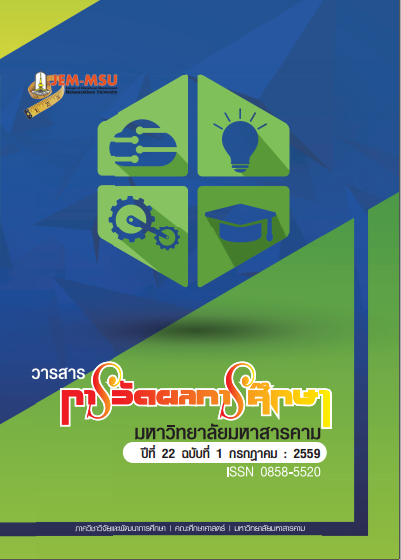Servant Leadership Of School Administration That Affective To Organizational Commitment Of Teacher Under Kalasin Primary Educational Service Area Office 3
Main Article Content
Abstract
The purposes of this research were to study and compare the level and relation
between servant leadership of school administrator and organizational commitment of
teacher under Kalasin Primary Educational Service Area Office 3, as classified by size of
school, age and education, as well as to the variables on servant leadership factors that can
predict all aspects of organizational commitment of teacher. The sample consisted of 327
teachers under Kalasin Primary Educational Service Area Office 3. The instrument used for
the study were a set of five-scale questionnaire. The statistics devices used in analyzing the
data included mean, standard deviation, t-test, One-way ANOVA, Pearson product-moment
correlation coefficient and Stepwise multiple regression analysis.
The findings were as follows:
1. Servant leadership of school administrator under Kalasin Primary Educational
Service Area Office 3 were rated at a high level.
2. Organizational commitment of teacher under Kalasin Primary Educational Service
Area Office 3 were rated at a high level.
3. Organizational commitment of teacher under Kalasin Primary Educational Service
Area Office 3, as classified by size of school and age were found statistically significant
difference at .05 level but educational certificate was found no significance.
4. According to the best prediction equation, it indicated that servant leadership
of the Persuasion (x5) Commitment to the growth of people (x9) and Healing (x3) could be
used as predictor for organizational commitment of teacher as a whole at 38.00 percent
with statistical significance of .05, The raw data and The standard scores predictable
equation could be written as follows:
= 2.19 + .20(x5)+ .15(x9)+ .16(x3)
∧Z
= .26(x5) + .20(x9) + .21(x3)
Article Details
The content and information contained in the published article in the Journal of Educational Measurement Mahasarakham University represent the opinions and responsibilities of the authors directly. The editorial board of the journal is not necessarily in agreement with or responsible for any of the content.
The articles, data, content, images, etc. that have been published in the Journal of Educational Measurement Mahasarakham University are copyrighted by the journal. If any individual or organization wishes to reproduce or perform any actions involving the entirety or any part of the content, they must obtain written permission from the Journal of Educational Measurement Mahasarakham University.


